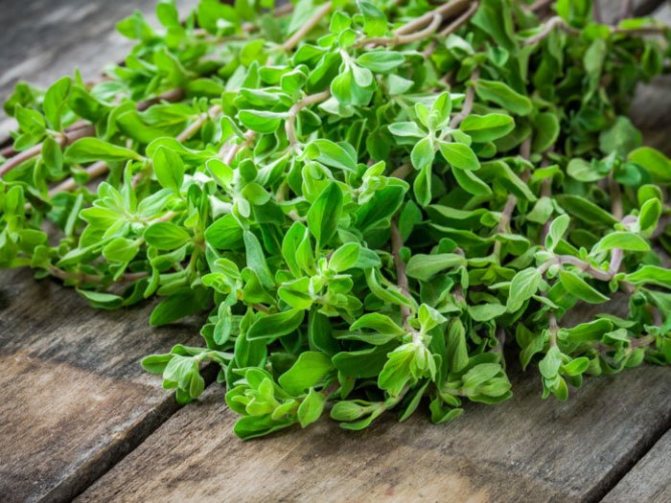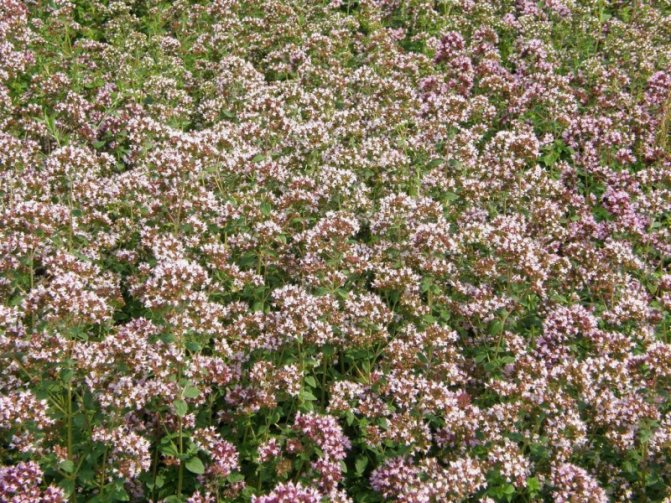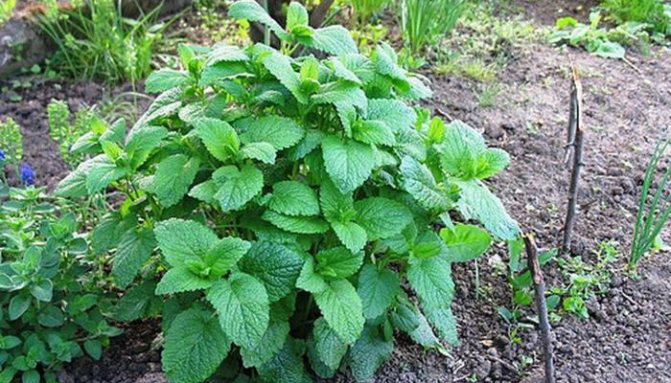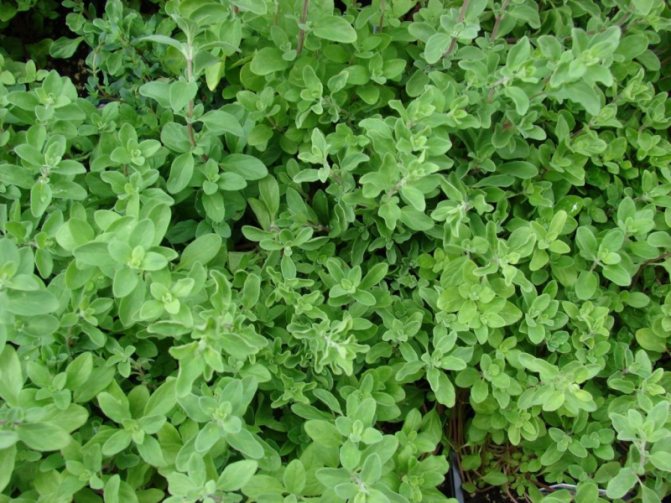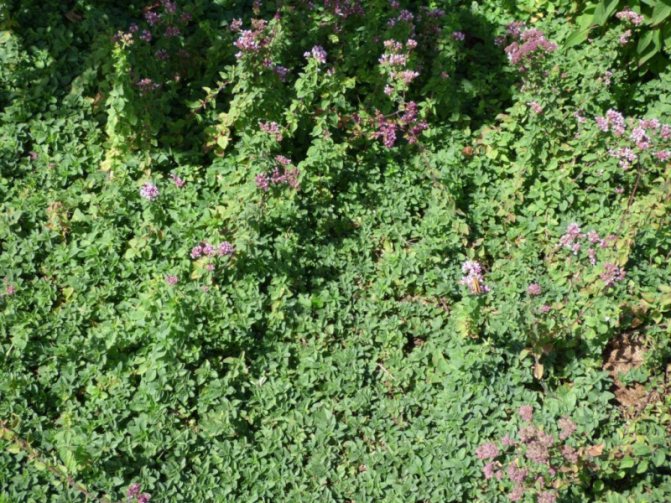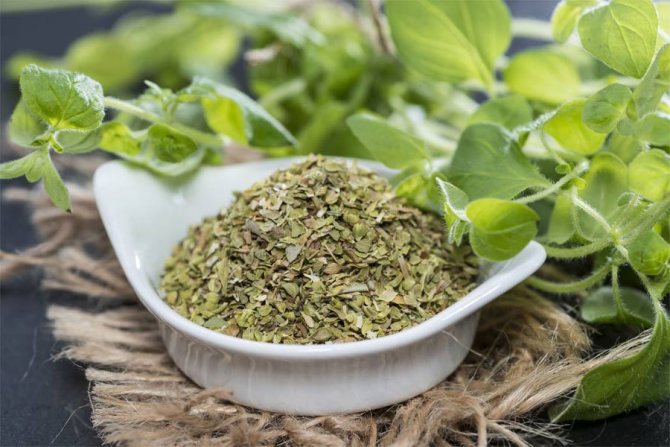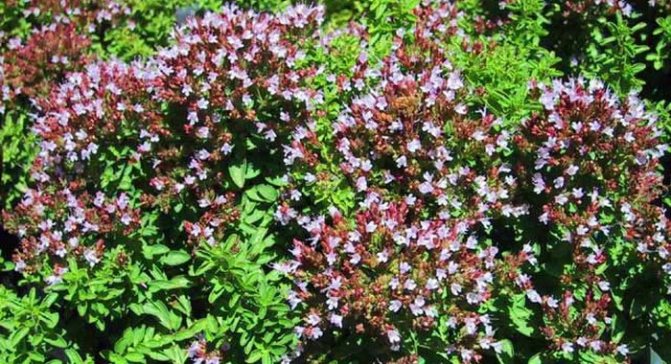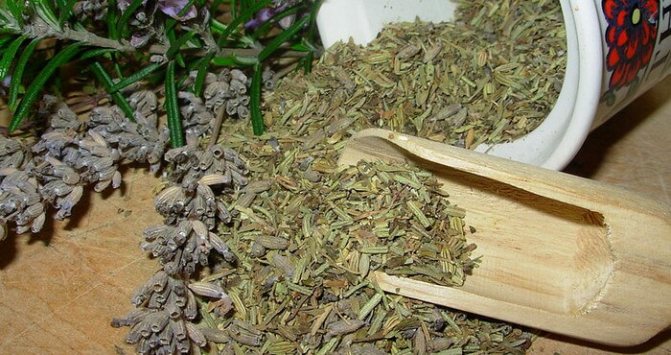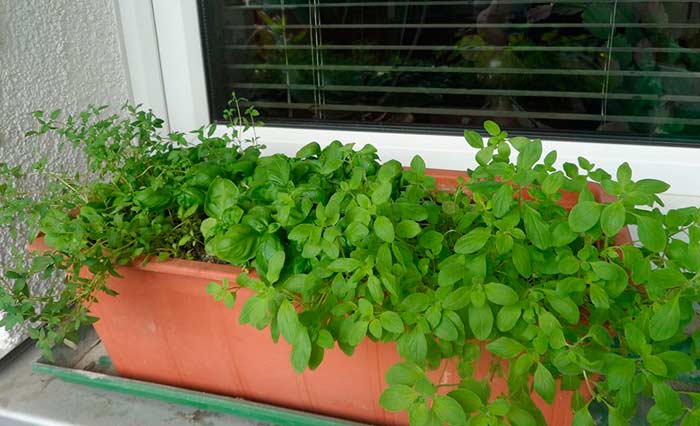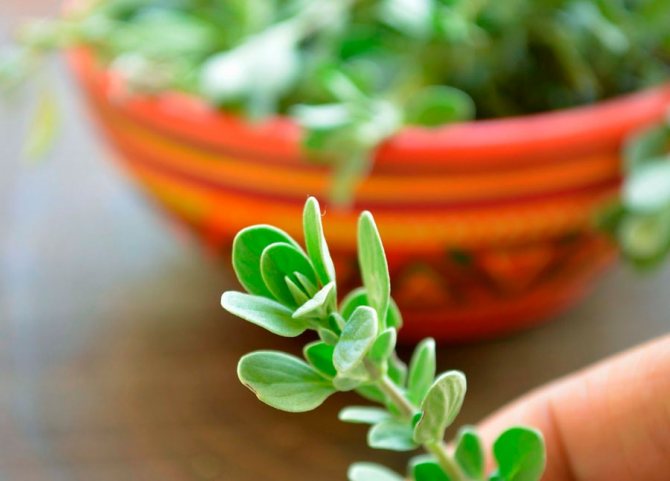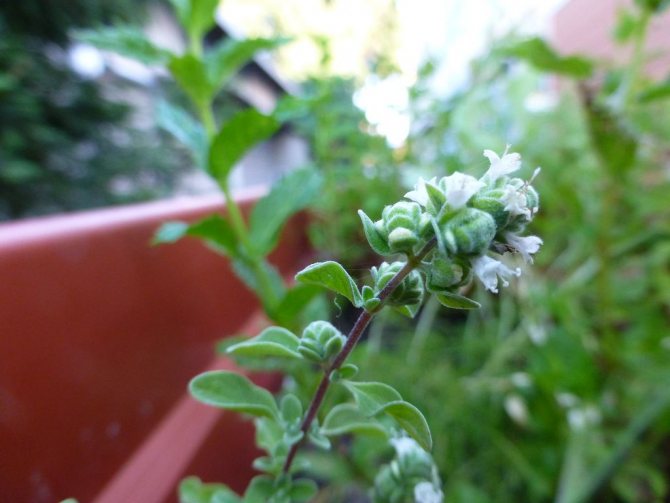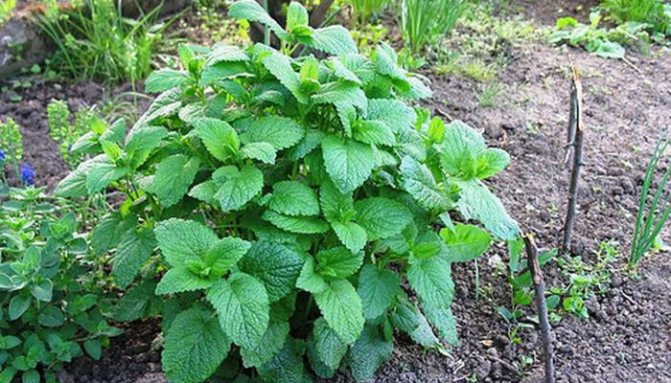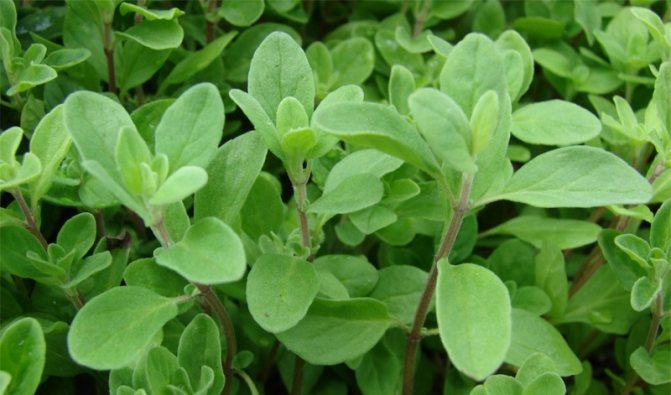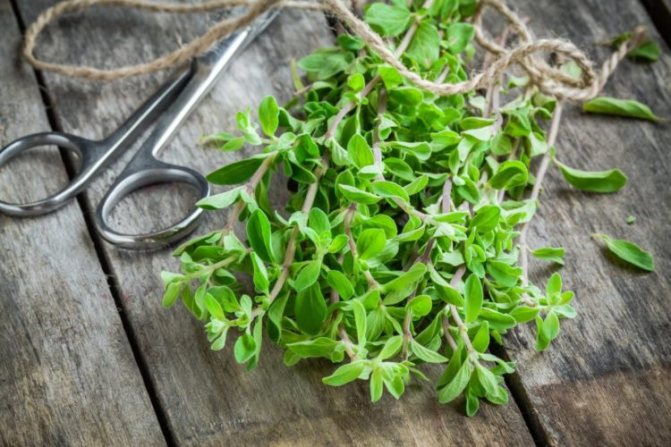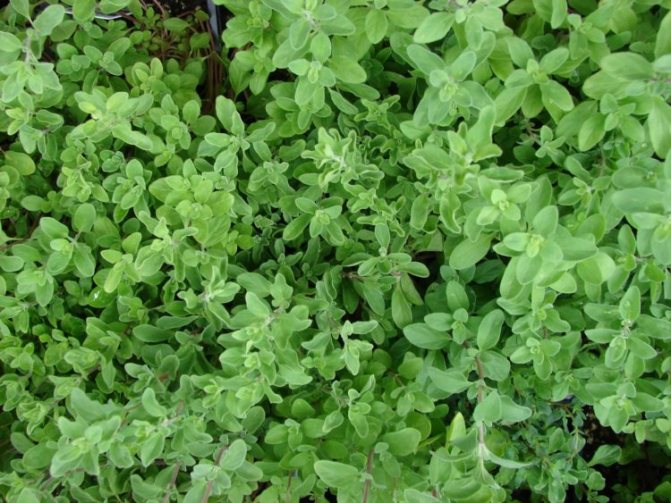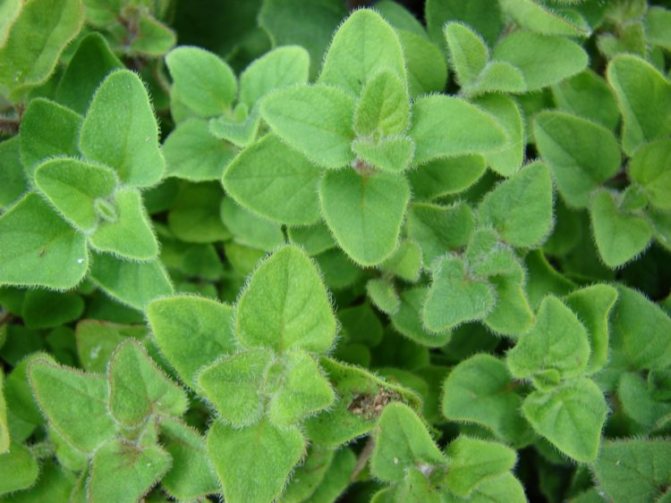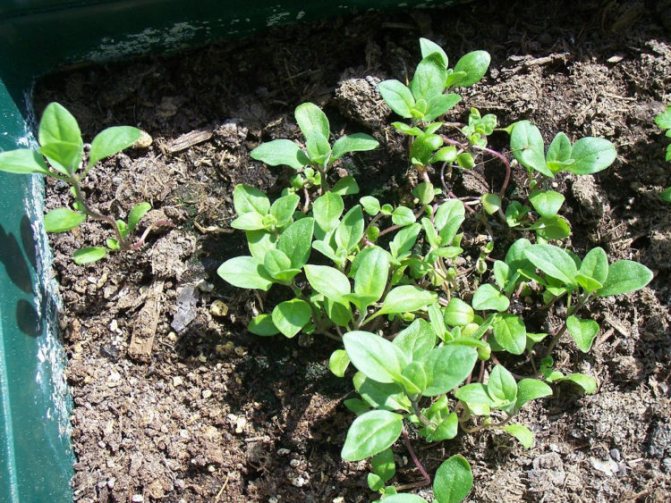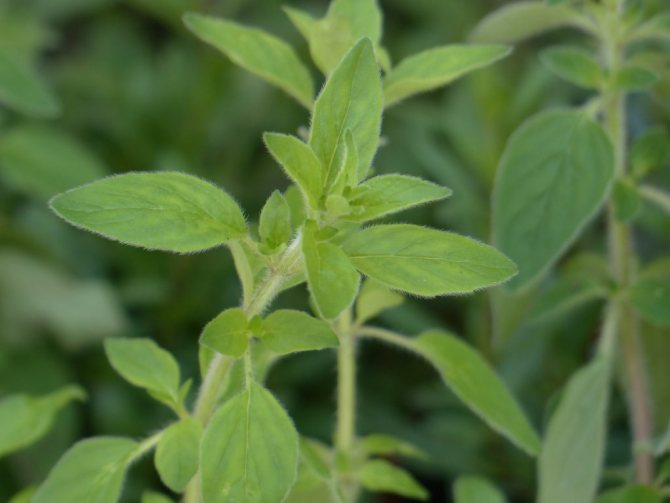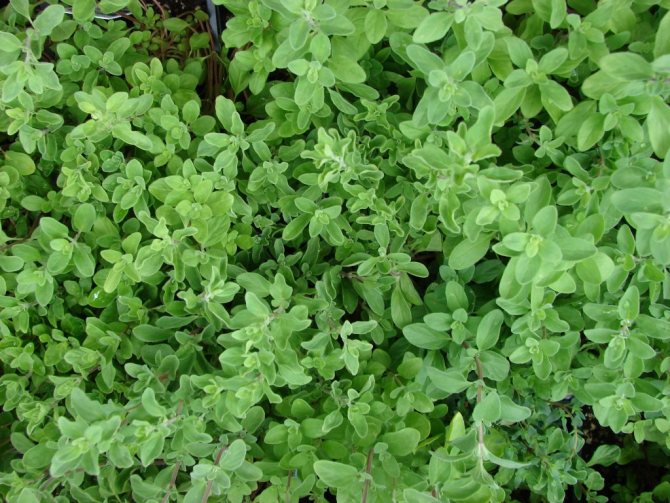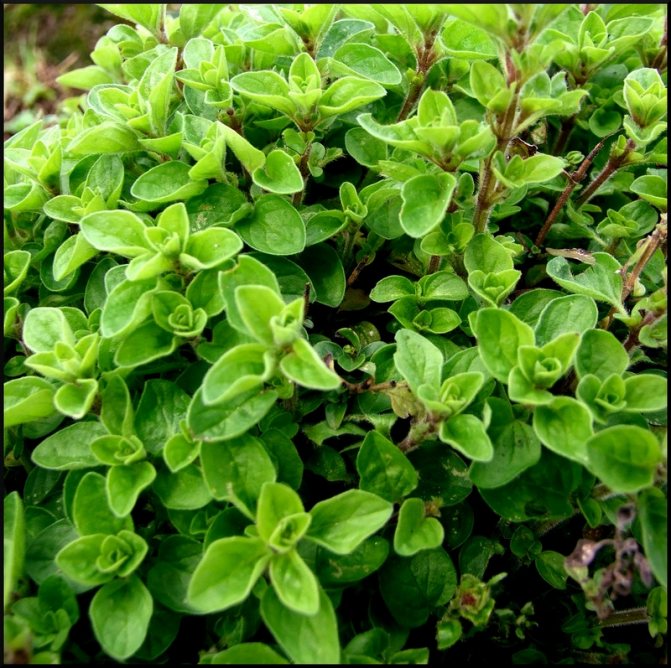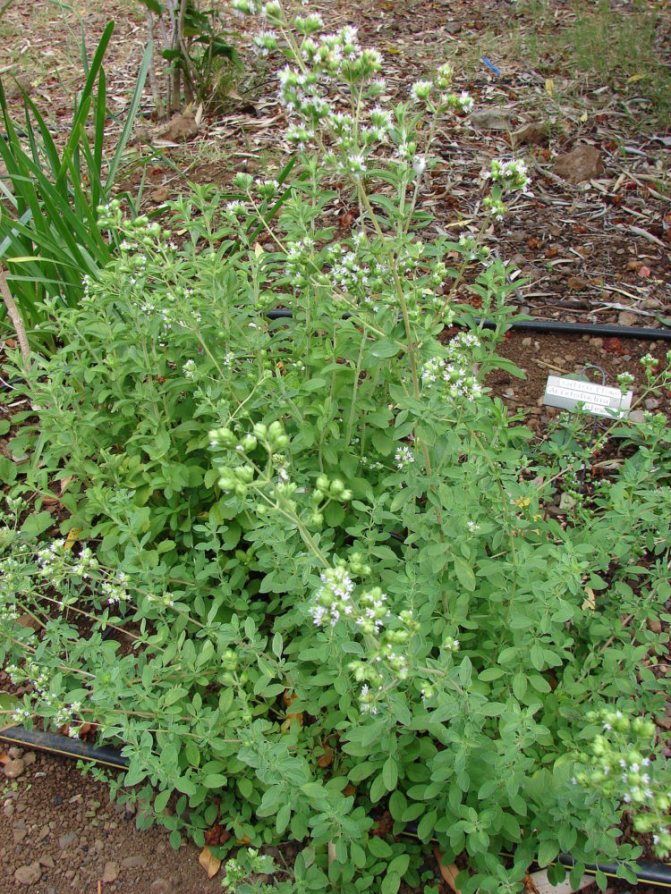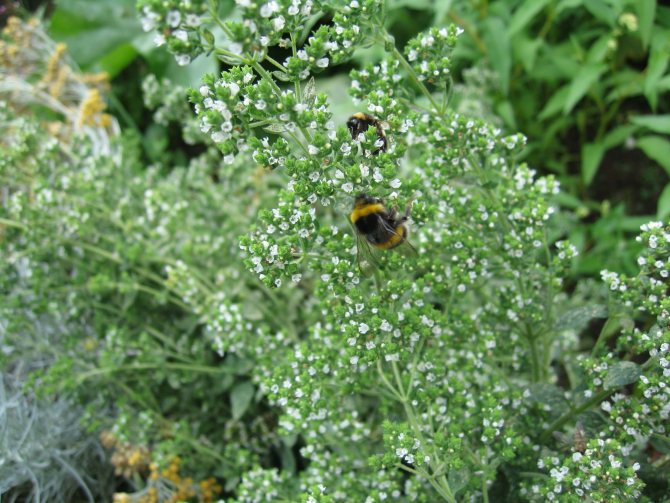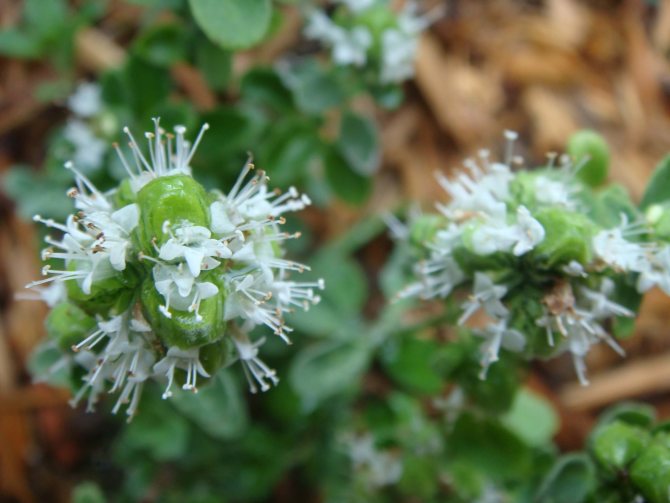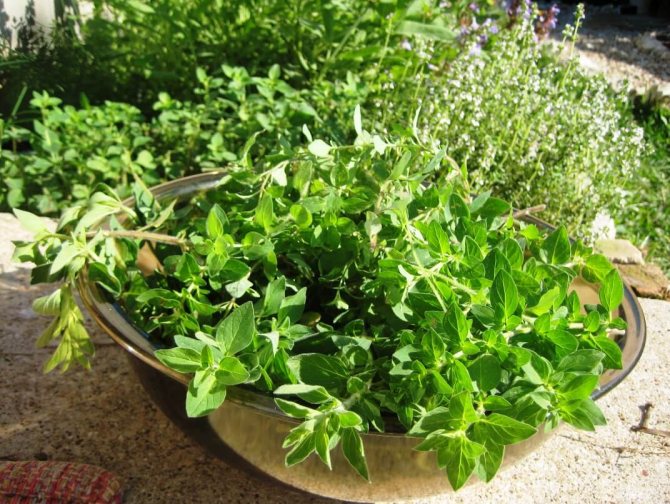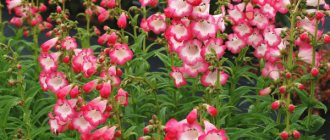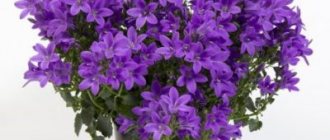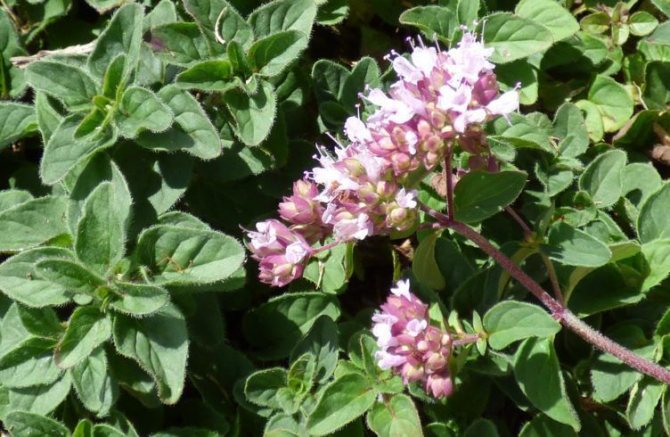
Marjoram is a perennial plant of the genus oregano. Especially popular in North Africa, Central Europe. In the Middle East, it is called bardakush and mardakush. Marjoram (Majorana syriaca) is a thermophilic culture. There are two types: leafy and floral. The latter is an annual of small stature and small flowers. Grown in Eastern Europe in greenhouses, therefore does not have the same aroma as leaf. Common in southern countries, marjoram is a sprawling shrub with fragrant leaves.
Marjoram description
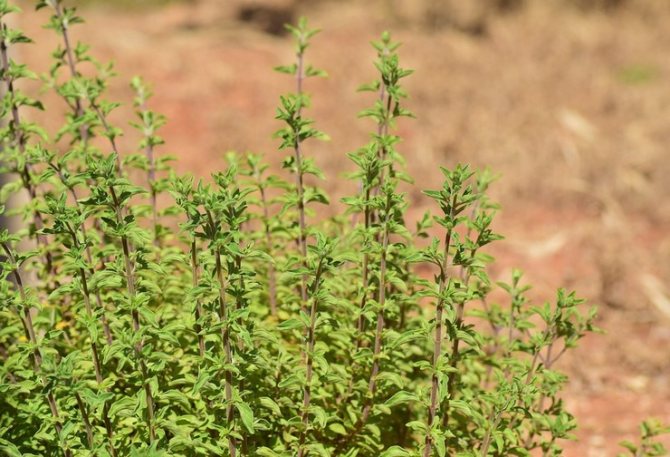

The height of the branchy gray shade of the stems reaches 20-50 cm. Closer to the surface of the substrate, the shoots become lignified. Oblong leaves have blunt ends and petiole base. Both the inner and outer sides of the plate are covered with a felt coating. The inflorescences consist of gray shaggy bunches of a rounded shape, which are woven into sessile spikelets. Most marjoram varieties start blooming in the middle of summer, then small buds with red or white or pink corollas appear on the stems. Marjoram bears fruit in egg-shaped nuts, smooth to the touch. For cultivation, mostly annual marjoram, called garden marjoram, is used.
Marjoram - Seasoning or Medicine?
Marjoram (English name - Marjoram, Latin - Origanum majorana). The plant is a subspecies of oregano (the second name is oregano, more about the amazing oregano and oregano), and they are very often confused. In some regions, oregano is called wild marjoram, and marjoram is called sweet marjoram, believing that they are practically indistinguishable. Most chefs do not share this opinion and believe that the differences are quite noticeable for the discerning taste. Marjoram has a milder flavor with citrus and woody notes, while oregano is much more pungent and spicy.
The Greeks called this plant “the joy of the mountains” and used it as a natural treatment for many ailments, including cramps, swelling and poisoning. In ancient Egypt, marjoram was used for healing, disinfection, and preservation.
Growing marjoram from seeds
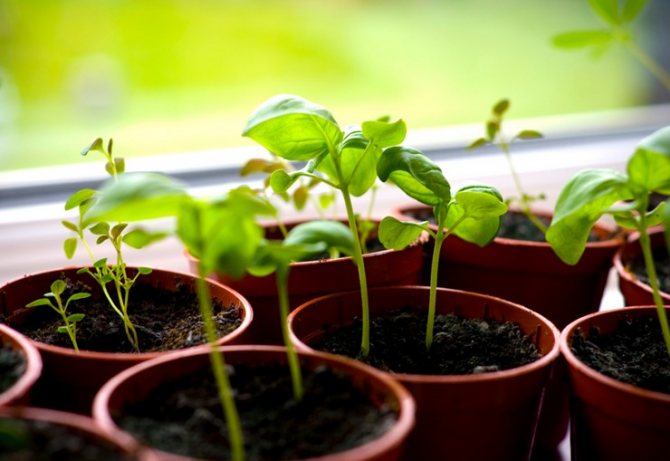

Sowing seeds
Growing marjoram is carried out using seedlings, so you will first have to do sowing. Seeds do not germinate well in open field conditions. Growing marjoram seedlings and caring for them do not cause difficulties for gardeners. Grass seeds are mixed with sand at a ratio of 1: 5. The optimal time to start sowing marjoram seeds is in April. Boxes for future seedlings are filled with a mixture of humus and turf at a rate of 1: 2, adding crushed chalk.
After the soil has been leveled and thoroughly moistened, grooves are dug at a distance of 4-5 cm from each other. The seeds are deepened by only a few millimeters and covered with a thin layer of earth. From above, the seedling boxes are covered with foil or glass and transferred to a room where room temperature prevails. The sprouts take at least 2-3 weeks to show up. Then the boxes are moved to a room with a lower temperature (about 15 ºC).
Marjoram at home
After the sprouts begin to grow in mass, they are watered as needed. The substrate should be moistened, but not overflowing with water.Wet ground will not do any good. In addition to watering, the soil is periodically loosened. In May, the first leaves of the seedlings are already formed. This is an excuse to transplant plants into a greenhouse or greenhouse. Here they will quickly get stronger and grow up. The picking stage is allowed to be skipped if the distance between the seedlings is taken into account in advance when planting.
The thermophilic marjoram plant does not tolerate even small frosts. Therefore, before sending it to the open ground, the grass is hardened. The film is regularly removed from the boxes, then the seedlings can quickly get used to the environment. The hardening process is extended from day to day so that the marjoram bushes get used to the fresh air. Moistening the soil for the hardening period is done a little less often than in the usual mode.
Growing conditions
When growing marjoram on a windowsill, a number of conditions must be observed. In this case, the plants will live for several years and will delight you with an abundant harvest of greenery. In this case, special attention should be paid to the level of illumination and timely fertilization. With a lack of light and nutrition, the plants gradually stretch out and die.
Lighting
Marjoram needs a lot of bright light for its successful development. Therefore, it is best to place the pot with it on south-facing windows. On the north side, the plant will have to be illuminated.
Temperature
The optimum temperature for growing marjoram in the house is + 18-20 ° C. In this case, the bushes grow dense and squat. The heat is fatal for marjoram. In such conditions, its shoots begin to stretch and dry out.
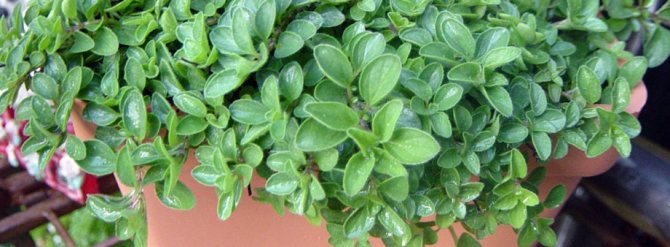

Marjoram can be grown on a glazed, frost-free balcony at + 10 ° C.
Air humidity
Homemade marjoram perfectly adapts to room conditions. In most cases, he does not need additional spraying. The only exceptions are those cases when the plant pot is located next to the heating radiators. In such a situation, to increase the level of humidity, small containers of water are placed next to the pot.
Planting marjoram outdoors
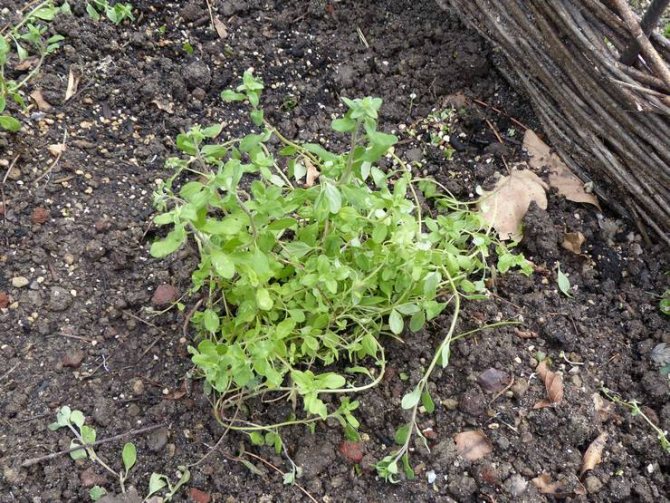

When to plant
Planting marjoram in open ground is carried out on condition that dangerous spring frosts are not returned. We are talking about the end of May or the beginning of June, when the weather has definitely stabilized. From 15 to 20 medium-sized seedlings are planted on the garden bed, since the culture shows a tendency to bushiness. From such a bed, you can collect a sufficient amount of the crop necessary for home use. The location of the site is chosen in the light, away from drafts.
For growing marjoram, sandy loam and loamy soil, fully warmed by the sun's rays, is suitable. Crop beds are best done on the site of previous potato plantings. They are prepared in advance of transplanting seedlings. The depth of the furrows should be about 20 cm. The site is also pre-fertilized with humus or compost, while adding mineral granules of superphosphate or potassium sulfate. The dug up bed is watered abundantly.
Landing scheme
Marjoram seedlings are transplanted into open ground in accordance with agrotechnical rules. The gap between the seedlings is kept from 15 to 20 cm.The rows themselves are placed at a distance of 40 cm from each other. The soil is moistened first. Handfuls of compost are poured into the holes, then seedlings are placed in them along with an earthen clod. The surface is tamped and watered. The rooting process takes about 2-3 weeks.
For successful adaptation, young marjoram bushes need protection from the scorching sun at midday and regular watering. When the seedlings take root properly, they are fed with saltpeter dissolved in water. Each square meter of the ridge takes about a bucket of water.
Varieties
Growing marjoram at home should start by choosing the right variety.
| Name | Height, cm | Greenery cut time, days | Features of the |
| "Baikal" | 55 | 100-110 | Strong aroma. |
| "Gourmet" | 60 | 120 | High productivity. |
| "Scandi" | 60 | 120 | Delicate spicy taste. |
| "Thermos" | 40 | 120 | High productivity. |
Marjoram care
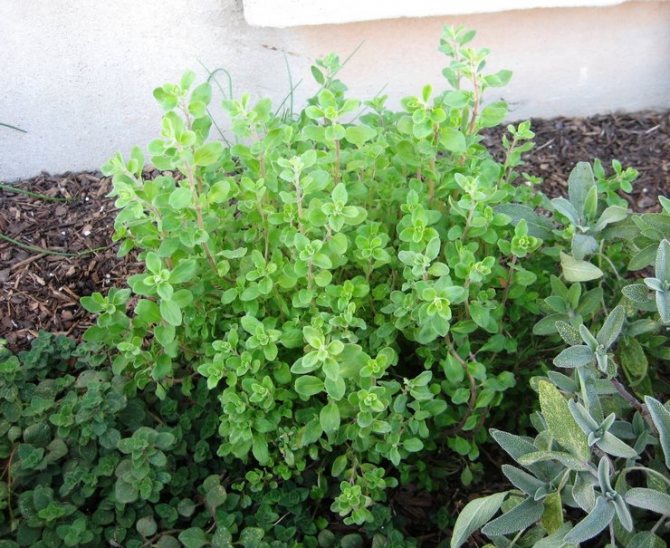

Caring for marjoram is exactly the same as for other crops. The area with sowing of grass is moistened, loosened and weeds are removed from it, fertilizing is applied and the plants are protected from pests. Weeding is of great importance, since the heat-loving plant reacts sharply to the lack of free space and the lack of drainage. It is recommended that you take care of your marjoram regularly and thoroughly.
Watering
The spice is drought tolerant, but still requires constant moisture. Without water, the leaves become faded and lose their attractiveness. Watering the plant is best done in the morning or in the evening with warm, settled water. In July, the volume of water applied under the bushes is halved and watering is organized only if a crust forms on the upper layer of the soil. Moistened soil must be loosened.
Feeding
Three weeks after planting seedlings on the site, the marjoram is fed with complex fertilizers. To do this, mix potassium salt, urea and superphosphate and dilute in a bucket of water. For the plant to grow and develop normally, such feeding is quite enough.
Diseases and pests
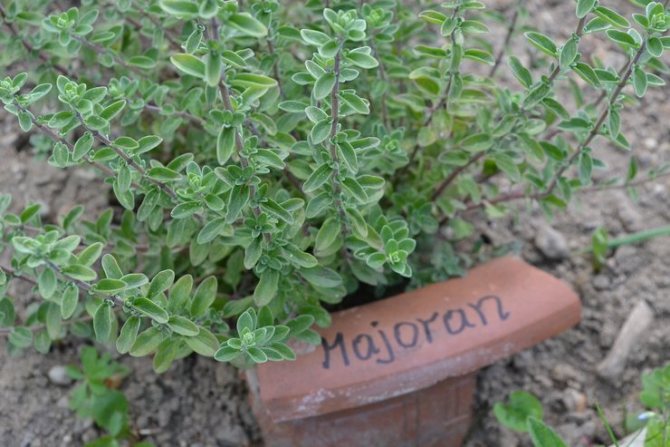

Young plantings of marjoram are susceptible to Alternaria disease, when the leaves are covered with spots. The consequences of the disease are the cessation of the growth of the grass. Alternaria is aggravated by damp weather and thickened crops. You can stop the spread of the disease by treating the foliage with fungicidal preparations.
Often there is an infection of the culture with moth larvae, which eats the ground green mass. Only spraying with insecticides destroys pests.
Watering
Marjoram tolerates short-term drought well. The need for abundant watering arises only at the beginning of growth. But it should be borne in mind that a lack of moisture leads to a decrease in yield.
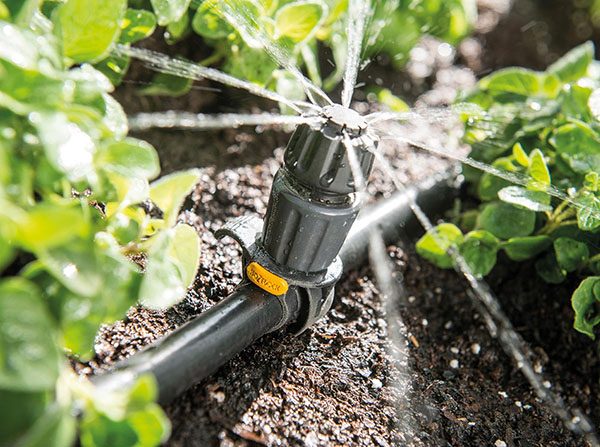

Young plants are watered most abundantly.
Before use, the water is slightly warmed up in the sun. Water the oregano beds in the morning or evening. Water consumption is reduced after the plant has faded and begins to bear fruit. If a crust appears on the surface of the soil, then the intensity of irrigation is slightly increased.
Collection and storage of marjoram
It is allowed to collect marjoram herbs several times during the season. For example, in July and September. The leaves of the plant are carefully cut with a sharp knife and washed under running clean water to get rid of the dust that has accumulated over time. Leaves are dried on paper, spreading them in a thin layer, or tied to the ceiling in attics or shelves. When the marjoram bunches are completely dry, the raw materials are sorted out and foreign debris or yellow leaves are separated. Then it is manually crushed and poured into glass jars, tightly closed with a lid. It is advisable to store the spice in a dark, dry place.
In the beds where marjoram was grown, vegetables such as turnips, carrots, beets or radishes take root well.
Composition and nutrients
The entire above-ground part of the mess is rich in essential oils; when dried, their concentration increases. The composition of the plant includes:
- tannins and pectin substances;
- zinc;
- magnesium;
- iron;
- copper;
- folic acid;
- potassium;
- selenium.
Marjoram is also rich in vitamins: A, B1, B2, B6, E, K. Fragrant spice has a cardamom smell and a taste similar to thyme.
100 g of the plant contains 271 kcal, 7 g of fat, 60.6 g of carbohydrates, 12.7 g of proteins. The fragrant culture has become popular among our summer residents. Fresh or dried spice adds zest to any dish. If you know how to plant and care for mayran correctly, then it is just right to grow it even on the windowsill.
Types and varieties of marjoram with photos
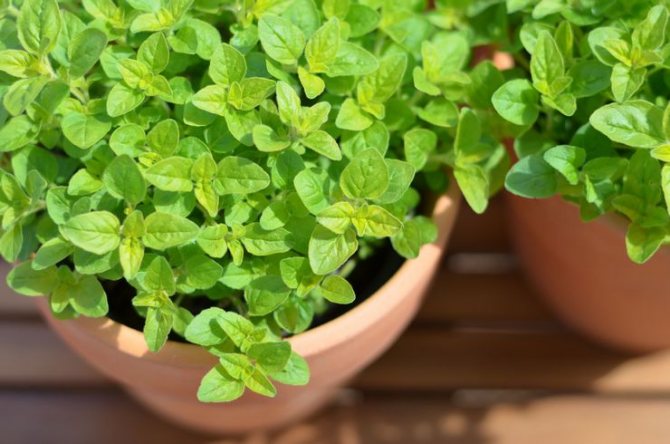

Gardeners prefer to grow only 2 types of marjoram: leaf and flower.The first type of grass has a strong, spreading stem and extensive vegetation, but it gives few inflorescences, the other is valued for its decorative and medicinal properties. The best varieties of marjoram include:
- Baikal - bushes of medium length, characterized by white lush spikelets, exuding a fragrant aroma, and attractive green foliage;
- Gourmet gives a high yield and ripens in about three months. The height of the stems reaches about 60 cm. The leaves of the plant are no less fragrant than that of the previous species, but the color of the leaves looks a tone lighter;
- Tushinsky Semko is a variety belonging to Russian breeders. The ripening period is 130-140 days. The bushes branch little, and the leaves are covered with a felt bloom. The lower part of the plant stiffens over time. The foliage is oblong with pointed ends. The flowers are made up of tiny buds that stretch out into long spikelets. The stems and leaves will be edible until flowering begins, then they can be consumed fresh;
- Thermos - has erect silvery stems that can grow up to 40 cm in length. The foliage is small, green in color. Inflorescences in white tones.
- Scandi is a medium-sized fragrant variety with small ovoid leaves with a smooth surface. The variety blooms with white inflorescences.
Harvesting
You can gradually pinch off the leaves from the plant already at the seedling stage. The main collection of greens is carried out during the flowering period. Cut the bushes with a knife or a sharp sickle, leaving a part of the stem 2 - 3 cm. The greens are tied in loose brooms or laid out on paper and dried in the shade. The dried herb is stored in a tightly closed container in a dark and dry place for many years.
For food use, it is better to chop dry foliage just before cooking so that the aroma is not lost.


After harvesting the greenery, the plot continues to be watered and fed. After a while, the stems with leaves will grow back. Before the onset of cold weather, you can have time to take another crop.
Properties and uses of marjoram


Beneficial features
The beneficial components of marjoram accumulate mainly in the flowering spikelets of the plant. Trace elements, pectins, flavonoids, phytoncides, vitamins, essential oils and other active biological substances were found in the tissues of the grass.
In folk medicine, marjoram is valued for a number of useful properties, for example, an herb:
- is an excellent remedy for toothache, relieves inflammation, strengthens the enamel and heals the gums;
- acts as an effective expectorant for lung diseases;
- used in the treatment of reproductive disorders, menstrual irregularities and other gynecological diseases;
- improves blood circulation and affects the formation of new blood cells;
- normalizes the functioning of the gastrointestinal tract and digestive processes, eliminates foci of inflammation in the intestines and helps to get rid of flatulence;
- has a diuretic effect and relieves swelling of the bladder;
- fights insomnia and has a calming effect on the body.
Recipes


Marjoram herbal infusions are recommended to be taken as tea. To prepare it, you need to take 2 tsp. dried herb powder and pour 2.5 tbsp. boiling water, then let it brew. Marjoram tea helps with headaches. Herbal ointments from the leaves are used for rheumatism, treatment of bruises, healing of abrasions and other wounds, as well as for colds in babies. To prepare a medicinal ointment at home, 1 tsp. dried herbs are mixed with 1 tsp. alcohol and 1 tsp. melted butter. The mixture is thoroughly warmed up in a water bath, squeezed through a sieve or cheesecloth and cooled. If a baby begins to have a runny nose, doctors advise mothers to lubricate the wings of the nose with this ointment inside.
Essential oil based on marjoram, which looks like a liquid tart and fragrant medicine, is of particular value in folk and official medicine.It is often used in aromatherapy to relieve tension, anxiety and feel refreshed and energized. Essential oil helps with warts and calluses. Just a few drops of marjoram oil, dissolved in olive oil, are enough to lubricate problem areas on the skin. The oil can also be added to conventional hand and foot creams. As a result, the skin becomes softer and more velvety.
Contraindications
An overdose of the herb causes severe migraine attacks. Due to the content of the hormone phytoestrogen, the marjoram plant is not recommended for pregnant women with thrombosis and thrombophlebitis. In large quantities, marjoram is dangerous for this category of people, so the seasoning should be used with caution so as not to provoke health problems. Small children under the age of five are not allowed to add flowers or marjoram leaves to their food.
Garden flowers Annual and biennial flowers
Diseases and pests
More often than not, the following pests parasitize oregano:
- Thrips. These small insects lay their eggs in the leaves, causing brown-brown spots to appear on the greenery. It is recommended to maintain optimal humidity conditions to prevent infestation. In the fight against thrips, Karate, Decis, and onion peel infusion help.
- Spider mite. The presence of this pest is indicated by a white spider web on the back of the leaf and yellow spots. Treating the plant with soapy water helps to get rid of the spider mite.
- Whitefly. A bright and noticeable insect, the activity of which causes the death of the culture. You can fight whitefly using an infusion of garlic.
Of the diseases, oregano usually affects Alternaria. When infected with this infection, dense brown spots appear on the leaves. At the same time, the growth of the bush slows down or stops.
If such signs occur, it is necessary to immediately treat the oregano with Bordeaux mixture or fungicidal preparations (Cuproxat, Kartotsid).
If you neglect this recommendation, the crop will quickly die.
Secrets of growing spices in a pot
If you don't have your own land plot, but you want to grow fresh greens, then you can sow marjoram in a flowerpot. The pot for grass should be 20 cm deep with a capacity of 1 liter, with water drainage. A mixture of vermicompost with coconut fiber mixed in a ratio of 2 to 1 is used as a substrate. A thick layer of gravel or expanded clay is placed on the bottom.
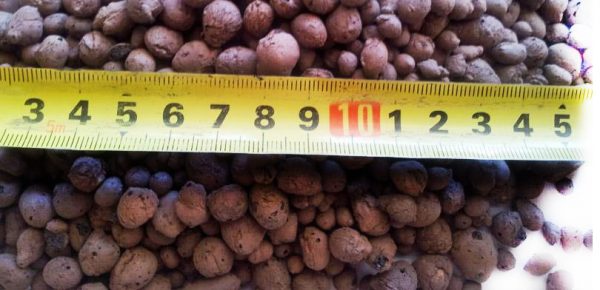

Expanded clay
Sowing is carried out with or without subsequent picking. Seeds pickled with potassium permanganate are deepened by 5 mm. The seedlings are then looked after as described above.
If the plant is planned to be transplanted into a larger container, then this is done after 4 real leaves appear on the bush. When planting, at this stage of development, a layer of earth of 10–20 mm is added immediately to the pots.
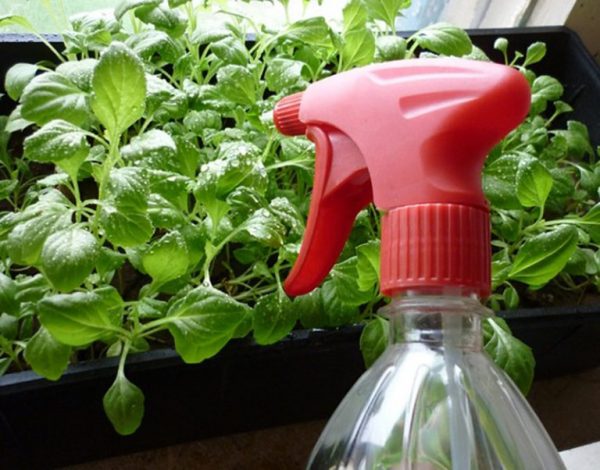

Irrigation of plants from a spray bottle
Water the plant as the soil dries up - every other day, every day it is irrigated with a spray bottle. Periodically, the soil is loosened. The first pruning of shoots occurs 4–6 weeks after sowing. Then the procedure is carried out as the branches grow. To keep the greens fresh and strong, water the plant regularly, abundantly in the summer, and moderately in winter.
Attention! Powdery mildew can develop from waterlogging of the plant.
The spicy herb prefers the sunny side. From a lack of light, the leaves turn pale, but do not die. In order for the marjoram to bush well, pinch it a month and a half after planting. Until late autumn, the plant can be kept on the balcony at temperatures up to +10 ° C.
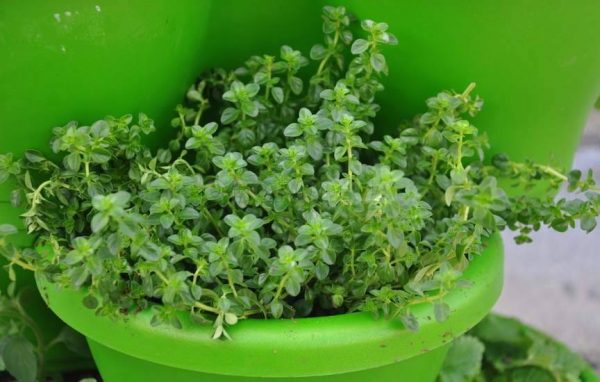

Potted oregano
Pot marjoram is grown as a perennial and dies after 2-3 years. To prolong the life of the bush, it should be fed. Oregano has a creeping root.If the plant grows, then it sprouts at the wall of the container. This allows you to get new shoots and rejuvenate the bush.
Table 2. Top dressing of marjoram growing in a pot (choose one of the fertilizers).
| Fertilizer name | Fertilizer amount | Method of application | Application frequency |
| "Height" | 0.5 caps for 1 liter of water | Watering | 1 time per month |
| Agrolife | 1 teaspoon | Add to the top layer of the substrate | 1 time per month |
| Biohumus liquid | 20 ml for 1 liter of water | Watering | 2 times a month |
Applied recipes
Marjoram, whose medicinal properties are well known, has long found universal application in many spheres of human life, therefore there are many different formulations that allow you to use it as efficiently as possible. The easiest way to make tea is from marjoram, for this you need to take 50 g of plant flowers and pour the raw material with 3 cups of boiling water, then insist for 10 minutes and strain. For the preparation of the solution, grass is equally suitable.
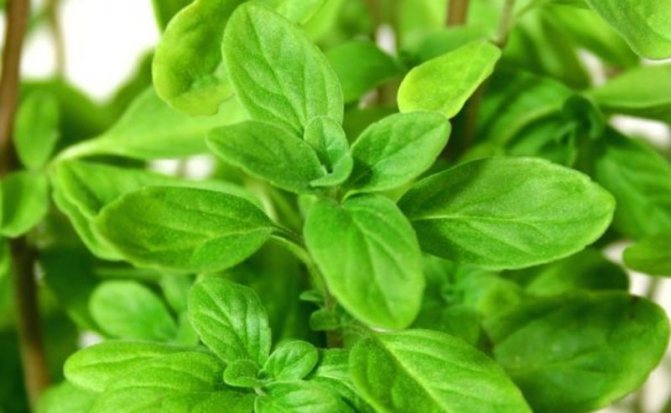

The best option would be to drink 3 glasses throughout the day, this will strengthen the immune system and allow you to cope with any disease.
There is also a recipe for making marjoram ointment, which helps a lot with all kinds of muscle sprains, runny nose in infants and rheumatism. To prepare it, it follows in 1 tbsp. l. alcohol dissolve 1 tbsp. l. marjoram powder. Then add 1 tbsp to the mixture. l. butter and put the composition in a steam bath for 10 minutes. Then strain and let cool the resulting ointment. Please note that the oil must be fresh and not contain salt. It is required to start application by simply rubbing a little of the resulting mixture into problem areas. If we are talking about a runny nose in a baby, then you can safely apply the medicine inside and outside the nose. The result will not be long in coming.
Content
- Listen to the article
- Description
- Growing marjoram from seeds Sowing
- Home care for marjoram
- When to plant
- Marjoram care
- Beneficial features
Useful qualities
The ancient Greeks were well aware of marjoram, the beneficial properties and contraindications for the use of which were contained in every serious book on medicine. It is required to consider the main positive aspects of this plant and the beneficial effect that it can have on human organs:
- Respiratory system. The use of the plant is extremely helpful in the healing of bronchi and asthma. It is used for severe coughs. Facilitates the course of the disease and removes phlegm.
- The gastrointestinal tract. In the tops of marjoram, such useful substances as carotene, rutin and ascorbic acid are concentrated. Together, they improve the functioning of the stomach and harmoniously affect a person's appetite. In addition, they stimulate the production of bile and gastric juice. It is permissible to give decoctions and infusions of marjoram to children with stomach cramps and flatulence.
- Anemia and female diseases. The composition of the raw material has a beneficial effect on the formation of blood cell mass and accelerates blood circulation, therefore in the 19th century it was used for serious wounds in soldiers. In gynecology, the plant can be used for general diseases of the genital organs, menstrual irregularities and dysfunctions of the reproductive system.
- Dentistry. Marjoram is known for its bactericidal and anti-inflammatory properties. If you rinse your mouth systematically, you can strengthen your teeth and gums, besides, it successfully cleans the enamel, which makes your teeth appear whiter.
Photo gallery
Contraindications and complications
Even in the form of a seasoning, marjoram should not be overly carried away.It is contraindicated in children under 5 years of age, pregnant and lactating women, people suffering from increased blood clotting and thrombophlebitis.
Overdose causes headache, nausea and depressed mood.
The Mediterranean is home to many spicy plants, one of which is marjoram. He loves warmth, and in our climate it acquires the status of an annual spicy culture. Many culinary experts widely use the seasoning from the dried leaves of this plant as an addition to the original first courses, meat and fish. With the help of young stalks of marjoram, add additional flavor to vinegar, sausages and preservation. Its flower buds serve to provide a richer flavor profile for pickled cucumbers and tomatoes.
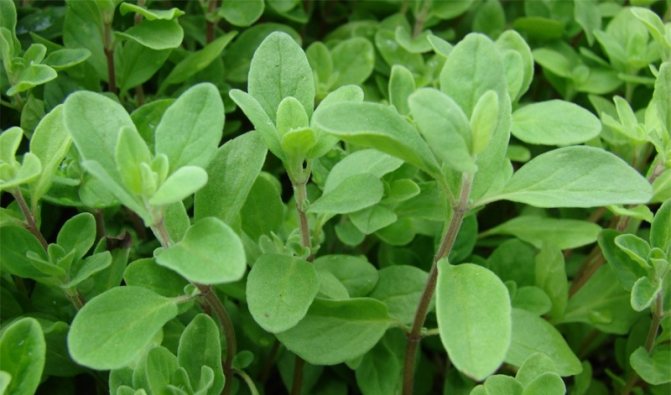

The Mediterranean is home to many spicy plants, one of which is marjoram
In the original translation from the Arabic language, marjoram means "incomparable". This is due to the explosion of taste that the plant can cause, as well as the healing properties inherent in the substances it contains. Our ancestors called it a less poetic name - sausage herb. The plant improves digestion and the functioning of the organs of internal secretion. In general, the spicy culture has a sweet, somewhat floral aroma and has a slight pungent taste.
Popular varieties
In culture, the only type is most often used - garden marjoram. In temperate climates, it is cultivated as an annual. On the surface of the branched stems, reddish streaks are present. Oval fluffy leaves grow close to each other and have a silvery-green hue. Varieties:
- Gourmand - a productive variety in just 3 months forms a sprawling bush 60 cm in height;
- Thermos - 40 cm tall silvery-gray stems that grow straight and are covered with small green foliage, and tiny white flowers bloom in summer;
- Crete is a low, spreading dwarf shrub with rounded velvety leaves of a gray-blue hue, dissolves light pink large flowers on drooping pedicels and exudes a spicy lemon aroma.
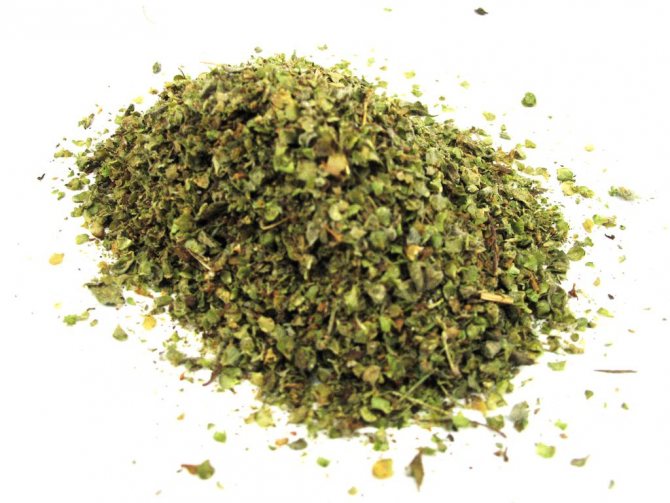

Types of garden spices
Gardeners' beds usually contain two varieties of this graceful plant - floral and leaf marjoram. The first is distinguished by the fact that it is rich in a large number of flowers, is more compact in size, and its leaves on the stem are sparse. Leaf, on the contrary, is more powerful, abundantly covered with green mass and blooms with only a couple of buds.
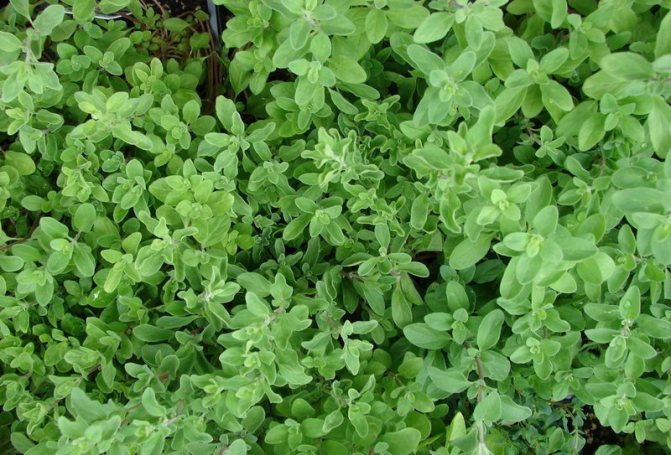

Gardeners' beds most often contain two varieties of this graceful plant - floral and leaf marjoram.
Cutting the grass must be carried out during mass flowering, and with a sharp blade, leaving stubble up to about 6 cm long. If you plan to use the plant fresh, then mowing is required as needed in the right amount. To harvest greenery in a dried form, it is necessary to cut everything off at the same time, this will allow the grass to not lose its useful qualities.
Top dressing
The first portion of fertilizer is applied to the garden bed 20 days after the transfer of seedlings. For this, a complex fertilizer is prepared (based on the processing of 1 m² of land), which includes:
- potassium salt and urea - 10 g;
- superphosphate - 20 g;
- water - 1 bucket.
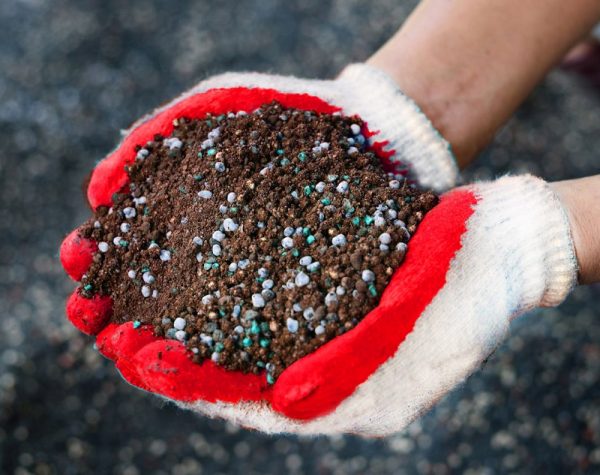

Starting feeding is carried out 21 days after transplanting seedlings
Superphosphate prices
superphosphate
What is it and how else can it be called?
Marjoram is a herbaceous perennial shrub from the Oregano genus of the Lamb family. Other names are bardakosh, mardakush, puffer, southerner, garden oregano, sausage herb. The Latin name is Origanum majorana ("Big oregano"). Marjoram is not a flower or a vegetable. Bardakosh is a herb. Marjoram is divided into two varieties - leaf (wild) and floral (garden).
The garden variety is a bush blooming with panicle inflorescences. The leafy variety is a highly branched shrub with many leaves.Long bloom, from July to August. Self-seeding is characteristic.
Marjoram is a valuable honey plant in the second half of summer. It is thermophilic and photophilous. What does it smell like? The aroma of marjoram is spicy, pronounced, reminiscent of the aromas of camphor, cardamom and mint, but sweeter and pungent.
Cooking applications
Marjoram is a very popular spice. It is difficult to single out a specific country, the homeland of the spice. She is popular everywhere. The taste of marjoram has fresh notes and a burning bitterness. When the leaves are rubbed, the smell of camphor with spicy and sweetish additives is felt. Seasoning is often used in the kitchen. It is added to sausages, main courses, soups, salads, stewed cabbage and legumes. The seasoning goes especially well with fatty dishes. It removes cloying and improves digestion.
Together with sage, basil and caraway seeds, you can get a particularly pleasant composition. The dried leaves are also added to hot drinks. Such a drink adds strength and perfectly warms, improves blood circulation and dilates blood vessels.
However, it is extremely important to observe the measure. If you overdo it with additives, the taste of the dish will cease to be felt.
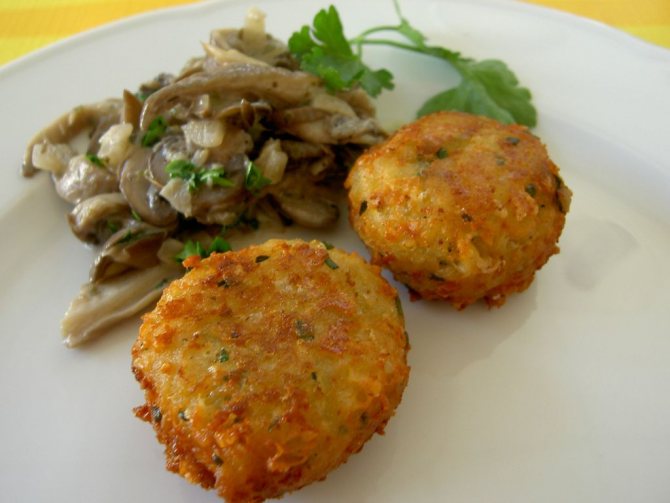

History and geography
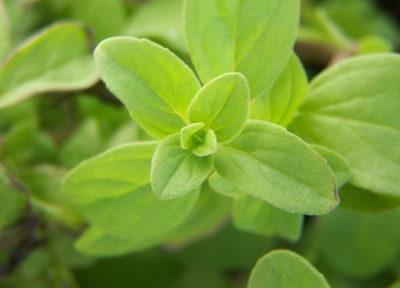

The plant is mentioned in the writing of Ancient Egypt, where it was used as a gift plant in the form of bouquets. In ancient Greece, marjoram was credited with mystical properties and influence on mood and life expectancy. In ancient Rome, bardakosh was considered one of the main aphrodisiacs and was used to create wreaths for newlyweds.
Marjoram was first used in cooking in the 13th century in France., where the plant was used in wine making and brewing. In the 16th century in Europe, marjoram was used as a tobacco substitute and in the preparation of liqueur.
Where does this plant grow? Marjoram is geographically distributed in the Mediterranean countries, Central Europe, Africa, South Asia, the Middle East, and is grown in Algeria, Egypt, Tunisia for industrial purposes. Bardakosh grows on moist fertile soils, prefers black soil.
Differences with some plants
With oregano
Marjoram and oregano are different plants, belonging to the same genus Oregano. The Latin name for marjoram is Origanum majorana ("Big oregano"), oregano is Origanum vulgare ("Simple oregano").
Marjoram is a whimsical plant that grows in southern countries, preferring open sunny spaces. Its aroma makes it suitable for meats, sausages and canned foods.
Oregano is an unpretentious plant, common in countries with temperate and cold climates, grows mainly in forests and is used in the preparation of herbal teas and medicinal preparations. The aroma of oregano is softer and softer than marjoram.
With oregano
What is the difference between marjoram and oregano and oregano? Marjoram and oregano are different plants belonging to the same genus Oregano, but oregano and oregano are the same plant. The differences between oregano and marjoram are indicated above.
Marjoram harvest time
Daily meals are prepared with fresh marjoram leaves. If there is a need for dry aboveground mass, the plots are cut off towards the end of July. The height of the remaining stumps is 6-7 cm.
The second time marjoram greens are harvested in early September, and under favorable conditions, at the end of August.
Good to know!
When planning a harvesting company, one should be guided by the fact that thermophilic marjoram stops growing green mass at 10-degree temperatures. Autumn frosts lead to the death of plants.
Bunches are formed from cut shoots. In this form, the stems are sent to the shade for subsequent drying. Leaves and flowers are torn off from the dried shoots, and the stems are thrown away. Coarse raw materials are suitable only for the preparation of medicinal baths. Dry marjoram is stored in glassware for 2 years.
Similar families
Plants similar to marjoram are represented by other members of the Lamiaceae family. They all have a similar structure, the type of foliage and inflorescences.
Most species of Lamiaceae are medicinal plants or used as a seasoning for food. These include:
- basil;
- savory;
- thyme;
- mint;
- rosemary;
- sage;
- Melissa;
- oregano;
- blackhead;
- iron box;
- motherwort.
Marjoram is a valuable spicy plant culture, which has long been used in cooking and medicine in many countries as a rich source of vitamins and essential oils. This plant has a lot of healing properties that effectively help with diseases of the respiratory system, intestines and skin. Marjoram is used as a natural food supplement serving as a salt substitute, it can increase appetite and enhance the taste of meat, fish and vegetables.


